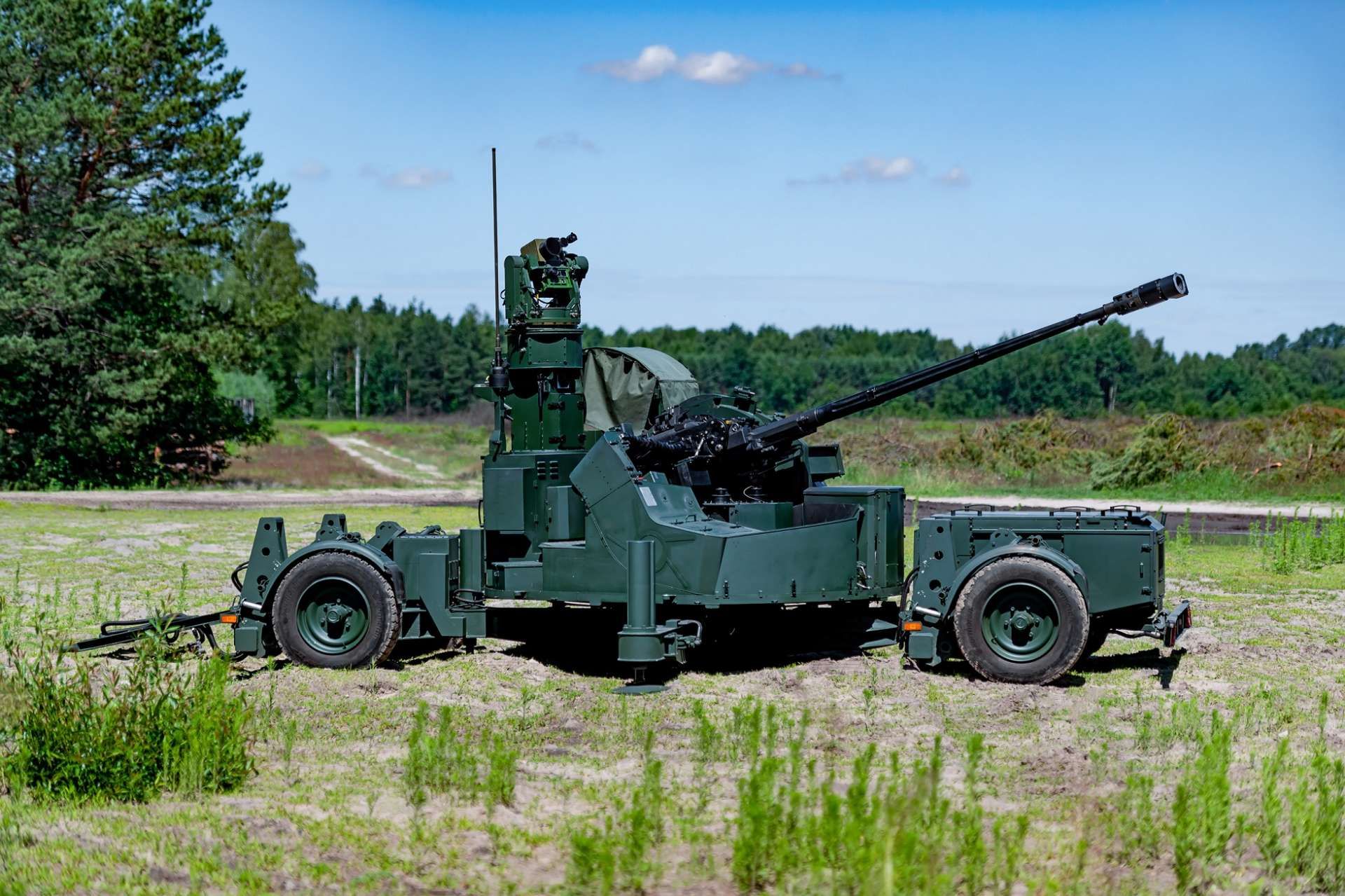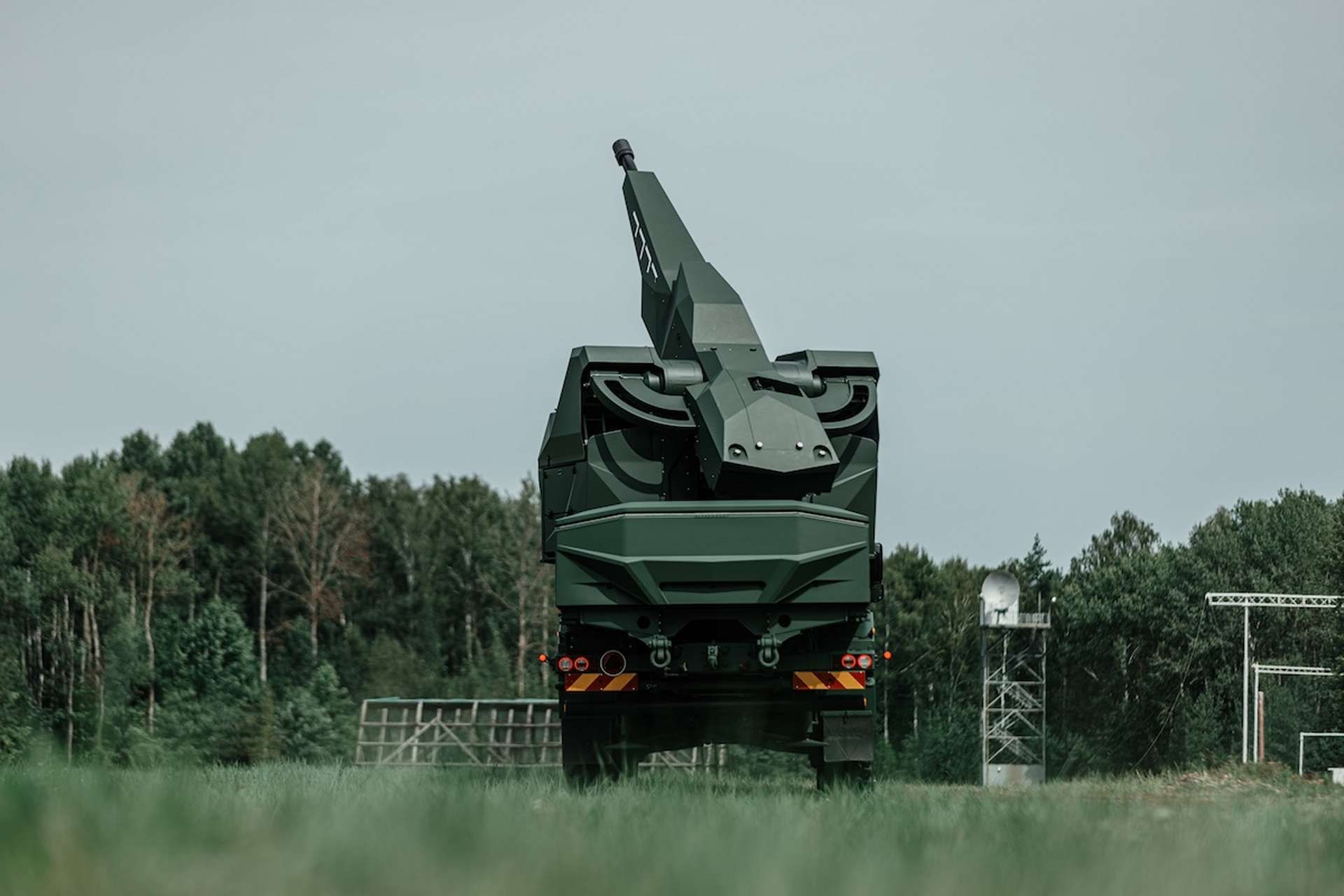Breaking News
Poland introduces SA-35MM counter-drone air defense system using programmable ammunition.
At the inaugural International Armament Congress, held from October 21 to 25, 2024, in Kraków, Poland, defense company Pit-Radwar presented a new 35mm self-propelled artillery system equipped with programmable ammunition. Designed to integrate into the evolving air defense architecture of the Polish Armed Forces, this system aims to enhance very short-range air defense (VSHORAD) capabilities against modern aerial threats, including drones, aircraft, and cruise missiles.
Follow Army Recognition on Google News at this link

The SA-35MM achieves a 97% hit probability using programmable ABM ammunition, with just seven projectiles releasing over 50 subprojectiles each. (Picture source: Pit-Radwar)
The newly unveiled system, named the SA-35MM, combines the AM-35mm automatic cannon with a programmable munition system. It features an independent optoelectronic target-tracking system called ZGS-35, a hybrid fire control system with the TUGA radar, and optoelectronic sensors. Mounted on a third-generation Jelcz 6x6 platform, the system is developed to engage a wide spectrum of air targets performing maneuvers in course, speed, and altitude within the fire zone, enabling effective short-term anti-aircraft defense of stationary strategic assets, troop concentrations, and mobile units.
The SA-35MM is particularly effective against low-cost, small, and very small targets, such as unmanned aerial vehicles (including kamikaze drones). The system is compatible with Polish air defense systems and is capable of autonomous target engagement, offering a high level of automation and remote control capabilities. Its design allows for fast mission readiness and deployment without manual alignment.
The AM-35mm automatic cannon has a rate of fire of 550 rounds per minute and features a two-sided, chained ammunition feeding system with a magazine capacity of 2 x 100 rounds. It can immediately switch between two types of ammunition, typically sub-caliber FAPDS-T (Frangible Armour Piercing Discarding Sabot with Tracer) and programmable Air Burst Munition (ABM), allowing it to effectively combat various airborne and ground threats. The cannon is reduced in size and weight by utilizing carbon fiber technology, and it can operate autonomously via its own remote-control console or integrated with a combat management system.
The ZGS-35 optoelectronic tracking system includes an infrared thermal imaging camera, a daylight camera, a high-repetition laser rangefinder, a video tracker, and a short-range interrogator. These components enable accuracy in dynamic object tracking, allowing the system to perform combat operations in various weather conditions, both day and night. The tracking head has an operational range in elevation from -10° to 85° and can perform continuous 360° rotation in azimuth. It provides range readout limits from a minimum of 200 meters to a maximum of 30,000 meters, with a ranging rate of 30 Hz.

The SA-35MM combines the AM-35mm automatic cannon with a programmable munition system and a third-generation Jelcz 6x6 platform. (Picture source: Pit-Radwar)
The TUGA radar, part of the hybrid fire control system, operates on continuous wave modulation by frequency (FMCW) with an active electronically scanned array (AESA) antenna in the X-band. This radar technology uses low transmitted signal power, making it difficult to detect by enemy reconnaissance devices, thus increasing operational security. Despite its low power and compact size, the TUGA radar has a detection range from 50 meters to 50 kilometers and can detect small drones at distances up to 5 kilometers.
The development of this artillery system is a collaborative effort involving Pit-Radwar, the Military University of Technology, and the defense company Mesko. The project is co-financed by Poland's National Centre for Research and Development (NCBiR), as part of Competition no. 12/2022 for projects in development works for state defense and security. The Tactical and Technical Assumptions have been approved by the AU Chief, with the objective to deliver nine prototypes after qualification tests, integrated with the OSU-35K naval gun system. The implementation period spans from December 20, 2022, to June 20, 2025.
During the congress, Pit-Radwar conducted demonstrations showcasing the system's capabilities. One test involved targeting a small unmanned aerial vehicle located 1,000 meters away, with an angular size of 0.5x2.0 milliradians. The AG-35 cannon achieved a dispersion of no more than 0.5 milliradians, closely matching the dimensions of the drone, demonstrating the system's precision.
Field test results indicated that achieving a 99% probability of hitting the target with at least one projectile required firing 24 rounds of typical TP-T/FAPDS-T ammunition. In contrast, using programmable ABM ammunition, firing only seven projectiles achieved a probability of hitting at the level of 97%, with each projectile releasing over 50 subprojectiles. This represents a significant reduction in ammunition consumption while maintaining a high probability of target destruction.

The objective is to deliver nine prototypes after qualification tests, integrated with the OSU-35K naval gun system, before June 20, 2025. (Picture source: Pit-Radwar)
Pit-Radwar proposed integrating the 35mm cannon into self-propelled artillery systems mounted on the AS-35 wheeled chassis. Two configurations for very short-range air defense (VSHORAD) batteries were suggested. The first, an artillery battery, would consist of four self-propelled SA-35 guns, a WG-35 fire control vehicle, a command vehicle, and a preliminary detection radar such as the Soła or Bystra systems. The second, a rocket-artillery battery, would include self-propelled Poprad missile systems enhanced with anti-drone technologies and a K-band tracking radar, in addition to the artillery components.
The SA-35MM system operates autonomously, equipped with its own fire control system based on the ZGS-35 optoelectronic tracking and aiming head. The integrated optoelectronic tracking head ensures accuracy in dynamic object tracking through its sensors, which include thermal imaging and daylight cameras, a laser rangefinder, and a video tracker. The system also features a communication and data transmission subsystem, enabling radio and cable communication with the battery command and control system and the WG-35 fire control vehicle, allowing for remote control from a portable terminal.
The drive subsystems of the gun and the optoelectronic tracking head are designed with advanced drive units and dedicated electronic controllers, providing high dynamics and precision of movement. An inertial navigation subsystem, including GPS, ensures accurate positioning and continuous measurement of azimuth angle, inclination, and tilt. The system also includes a non-kinetic UAV neutralization system and emphasizes cost-efficiency by reducing logistics and personnel requirements, thereby lowering life-cycle costs.
Public and expert reactions at the congress reflected interest in the potential implementation of the system. The presentation of this new 35mm air defense system underscored its significant advantage in reducing ammunition consumption while maintaining effectiveness, especially when compared to 23mm caliber systems. This efficiency is largely attributed to the use of programmable ammunition in the 35mm system, enhancing precision and operational capability.
Observers expressed hope that the program would be carried out consistently, with some anticipating the first batteries to be operational by 2026. Others highlighted the necessity for mass production to ensure the security of key facilities and troops, especially given the increasing use of drones in modern conflicts, such as in Ukraine, Gaza, or Lebanon.

An inertial navigation subsystem, including GPS, ensures accurate positioning and continuous measurement of azimuth angle, inclination, and tilt. (Picture source: Pit-Radwar)


























